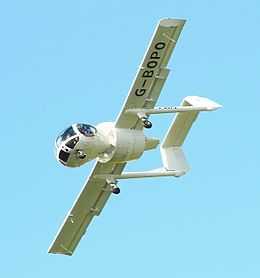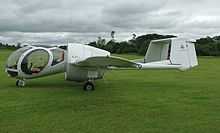Edgley Optica
| EA-7 Optica | |
|---|---|
 | |
| Edgley Optica G-BOPO at the 2008 Sywell Airshow | |
| Role | Observation |
| National origin | United Kingdom |
| Manufacturer | Edgley |
| Designer | John Edgley |
| First flight | 14 December 1979 |
| Number built | 21 |
|
| |
The Edgley EA-7 Optica is a British light aircraft designed for slow-speed observation work, and intended as a low-cost alternative to helicopters. The Optica has a cruise speed of 130 km/h (70 kn; 81 mph) and a stall speed of 108 km/h (58 kn; 67 mph).
Design and development


The Optica project began in 1974 with a company, Edgley Aircraft Limited, formed by John Edgley who, with a small team, designed and built the original prototype. In 1982, institutional investors bought into the project and set up a production line at Old Sarum Airfield in Wiltshire. Over the next three years, the company was built up to full manufacturing capability, the aircraft received UK certification, and the first customer aircraft was delivered. Despite this success, the additional investment necessary for the final phase of full production was not forthcoming, the business went into receivership, and John Edgley was forced out. With new owners, the project continued to be a success, aircraft on the production line were completed, and the Optica entered service.
The Optica, designed by John Edgley, has an unusual configuration with a fully glazed forward cabin, reminiscent of an Alouette helicopter, that provides 270° panoramic vision and almost vertical downward vision for the pilot and two passengers. The aircraft has twin booms with twin rudders and a high-mounted tailplane. It is powered by a Lycoming flat-six normally-aspirated engine situated behind the cabin and driving a fixed pitch ducted fan. Due to the ducted fan, the aircraft is exceptionally quiet. The aircraft has a fixed tricycle undercarriage with the nosewheel offset to the left. The wings are unswept and untapered. The aircraft is of fairly standard all-metal construction with stressed aluminium skin.
The aircraft's distinctive appearance has led to it being known as the "bug-eye" in some popular reports.[1]
Operational history
The Optica, powered by a 160 hp (119 kW) Lycoming IO-320 engine, made its maiden flight on 14 December 1979 [2] when it was flown by Squadron Leader Angus McVitie, the chief pilot of the Cranfield College of Aeronautics.[3]
The Optica, upgraded to the more powerful Lycoming IO-540,[4] entered production in 1983. Edgley Aircraft Limited obtained its initial Civil Aviation Authority certification on 8 February 1985.[5]
A total of twenty-three Opticas have been manufactured, and construction of two more began but was not completed. Ten aircraft were destroyed in a fire at the factory.
The Optica went through several changes of ownership, until FLS Aerospace (Lovaux Ltd) took over the rights, together with the design and manufacturing rights to the Sprint: a two-seat ab-initio trainer that had been designed by Sydney Holloway in Cornwall UK at about the same time as the Optica. Lovaux had intended to develop both aircraft, with the Sprint intended as the military trainer for the UK forces. Unfortunately, the Sprint was not adopted for this role, and Lovaux cancelled both projects.
The Optica and the Sprint together then passed through other owners until, in 2007, they were offered to John Edgley who formed a new company, AeroElvira Limited, with three former employees of Edgley Aircraft (Chris Burleigh, Fin Colson and Dave Lee) who at that time were working on both projects for the then-owners. The new company successfully put G-BOPO back into service as a UK demonstrator, with a first return-to-service flight on 3 June 2008.[6][7] AeroElvira is now assessing market conditions with a view to restarting production of the Optica.[8]
Accidents and incidents
On 15 May 1985, Optica G-KATY crashed killing its Hampshire Constabulary pilot and his photographer passenger.[9] The UK Department of Transport Accidents Investigation Branch found, inter alia, that: "There was no indication that either structural or mechanical failure had occurred or of flying control manfunction or jamming." and that "The final loss of control was caused by either the aircraft stalling in a turn at a high angle of bank, or the nose dropping or inadvertant interference with the controls by the photographer alarmed by his apparent insecurity."[10]
On 11 March 1990, G-BMPL, while in flight, sustained damage to the ducted fan and hub assembly and minor airframe damage. The pilot performed a successful forced approach landing: there were no injuries and no further damage to the aircraft. As a result of this incident and the subsequent investigation, the manufacturer issued a service bulletin calling for a hub inspection before further flight, and the CAA issued a Mandatory Airworthiness Notice (No. 004-05-90). The Optica fan has now been replaced by one designed and manufactured by Hoffman Propeller.[11]
In popular culture
An Optica was featured in the 1989 movie Slipstream.[12]
An Optica was featured in the 1985 anime, Mobile Suit Zeta Gundam piloted by, Amuro Ray.
Specifications
Data from Jane's All the World's Aircraft, 1988–1989[13]
General characteristics
- Crew: one pilot
- Capacity: two passengers
- Length: 8.15 m (26 ft 9 in)
- Wingspan: 12.0 m (39 ft 4 in)
- Height: 2.31 m (7 ft 7 in)
- Wing area: 15.8 m² (171 ft²)
- Airfoil: NASA GA(W)-1
- Empty weight: 948 kg (2,090 lb)
- Useful load: 367 kg (810 lb)
- Max. takeoff weight: 1,315 kg (2,900 lb)
- Powerplant: 1 × Textron Lycoming IO-540-V4A5D flat six piston engine, 194 kW (200 hp)
- Propellers: five bladed ducted fan propeller, 1 per engine
Performance
- Never exceed speed: 259 km/h (140 knots, 161 mph)
- Maximum speed: 213 km/h (115 knots, 132 mph)
- Cruise speed: 130 km/h (70 knots, 81 mph) "loiter speed" at 40% power
- Stall speed: 108 km/h (58 knots, 67 mph)
- Range: 1,056 km (570 nm, 656 mi)
- Endurance: 8 h (at loiter speed)
- Service ceiling: 4,275 m (14,000 ft)
- Rate of climb: 4.12 m/s (810 ft/min)
- Wing loading: 83.0 kg/m² (17.0 lb/ft²)
- Power/mass: 0.148 kW/kg (0.0897 hp/lb)
Avionics
1 × IR/Camera Turret in recessed bay in nose. 1 x Skyshout Loudspeaker (Police Equipment)
See also
- Aircraft of comparable role, configuration and era
- Brdischka HB23 Scanliner
- Heston JC.6
- Seabird Seeker
References
- Notes
- ↑ Flight International 12 May 1979, p.1591.
- ↑ Flight International 12 May 1979, p.1594.
- ↑ Flight International 29 December 1979, p.2111
- ↑ Flight International 21 April 1984,p.1111.
- ↑ Taylor 1988, p.294.
- ↑ Aero Elvira (Design Owners) - www.aeroelvira.co.uk Access date: 23 March 2008
- ↑ "Optica flies again in UK". Flyer.co.uk. 5 August 2008. Retrieved 25 August 2008.
- ↑ "Edgley seeks buyer for Optica observation aircraft"
- ↑ Hampshire Council
- ↑ Accident report p. 24, paras 6, 10.
- ↑ http://www.aaib.gov.uk/cms_resources.cfm?file=/Brooklands%20Aerospace%20Group%20plc%20OA7%20Optica,%20G-BMPL%2010-90.pdf
- ↑ Slipstream (guest review)- www.post-apocalypse.co.uk Access date: 9 December 2007
- ↑ Taylor 1988, p. 294–5
- Bibliography
- "Optica—the bug-eyed observer". Flight International: pp.1591–1594. 12 May 1979.
- "Optica enters production". Flight International: pp.1111–1114. 21 April 1984.
- "No cause found for Optica crash". Flight International: p.54. 30 August 1986.
- Donald, David (Editor) (1997). The Encyclopedia of World Aircraft. Aerospace Publishing. ISBN 1-85605-375-X.
- Taylor, JWR (Editor) (1988). Jane's All the World's Aircraft, 1988-1989. Jane's Information Group. ISBN 0-7106-0867-5.
External links
|
| |
|
| |
|
|
 Media related to Edgley Optica at Wikimedia Commons
Media related to Edgley Optica at Wikimedia Commons- Edgley Optica in the air Flight International 1980
- Optica Revisited Flight International 1985
- AeroElvira
- Optica
| ||||||||||||||||||||||